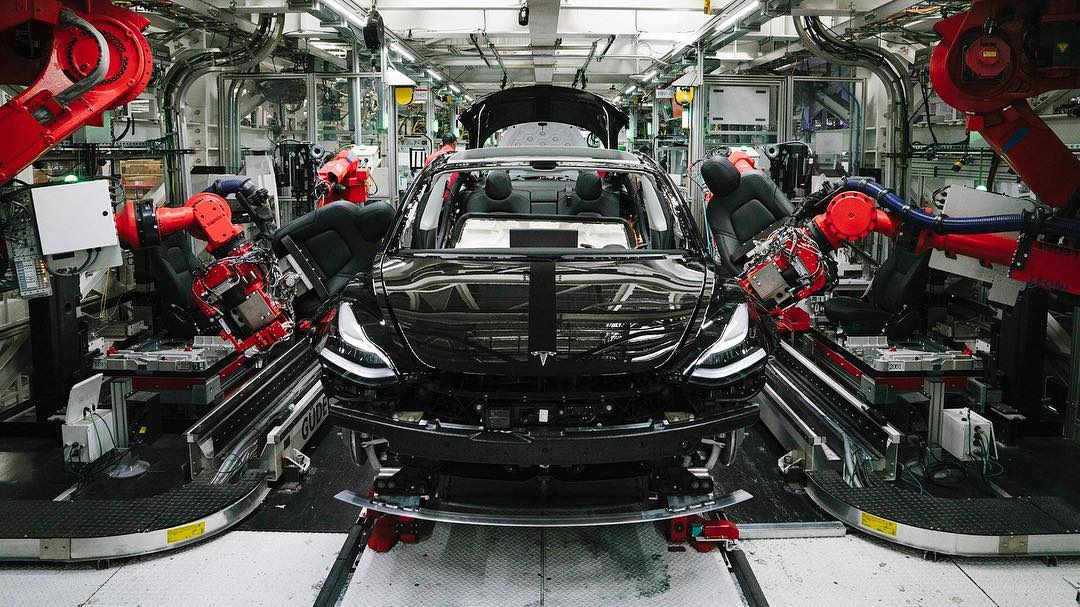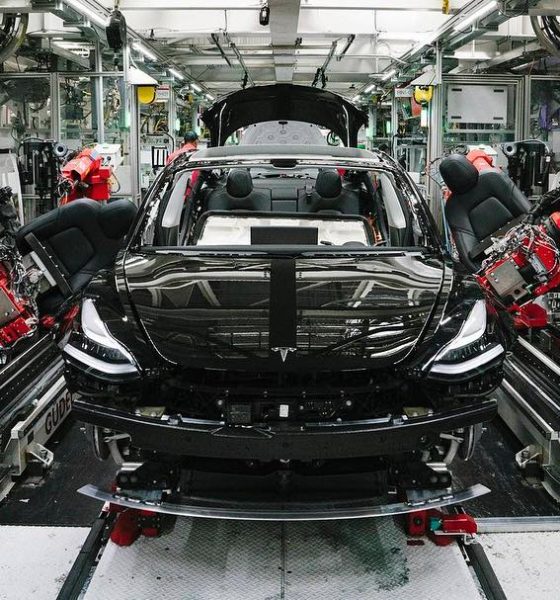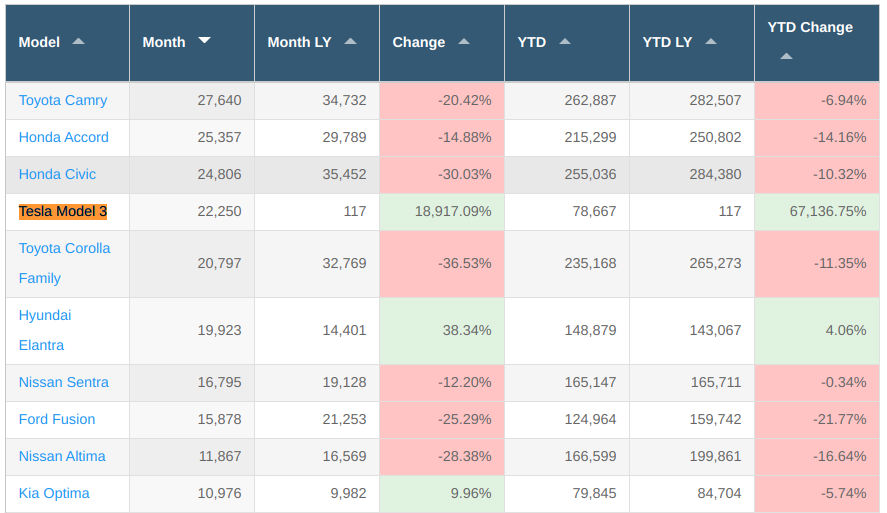

Investor's Corner
Tesla Model 3 ramp continues amid 4.6k new VIN registrations, higher US sales rankings
Tesla might have just finished a record third quarter, but the electric car maker seems set to push forward with its Model 3 ramp without missing a beat. Just yesterday, Tesla registered 4,609 new Model 3 VINs, ~85% of which are estimated to be Dual Motor. With this latest batch of filings, Tesla has registered a total of 122,517 Model 3 to date.
The recent batch of Model 3 VIN filings bode well for Tesla’s continued push for the electric car this Q4. Tesla’s chances this fourth quarter has gained the confidence of some Wall Street analysts, including Romit Shah of Nomura Instinet, who noted that Tesla might have hit its break-even point in the third quarter. The analyst also noted that as Telsa closes in on production and delivery numbers of 100,000 vehicles per quarter, the company could finally reach a point where it could be sustainably profitable.
#Tesla registered 4,609 new #Model3 VINs. ~85% estimated to be dual motor. Highest VIN is 122517. https://t.co/TBGgTxH3DS
— Model 3 VINs (@Model3VINs) October 3, 2018
It should be noted that Tesla’s production ramp for the Model 3 is only partly done. Tesla eventually aims to produce 10,000 units of the electric sedan every week, and so far, the company is only producing around half this number on average. Despite this, the Model 3’s disruption of the US auto market has started becoming notable, particularly in the sales figures of rival automakers in September. The Tesla Model 3 has slowly risen through the ranks of the US’ best-selling passenger cars over the past months. This became particularly notable in August, when the Model 3 was listed by auto sales tracking website GoodCarBadCar as the 5th best-selling passenger car in the United States.
The Model 3 went up GCBC‘s best-selling passenger cars list once more in September. Tesla sold an estimated 22,250 Model 3 in during the month, beating the Toyota Corolla Family for the No.4 spot. What’s particularly notable was that with the Model 3’s rise, the sales of the three vehicles above it — the Toyota Camry, the Honda Civic, and the Honda Accord — all saw a notable dive. Looking at September’s sales figures, the gap between the Model 3 and America’s best-selling passenger cars continues to get smaller.

The Tesla Model 3’s rankings at the auto sales tracking website’s overall list also improved. Last August, the Model 3 was listed by GoodCarBadCar as the 15th best-selling vehicle in the United States. In September, the Model 3 moved up two places, ranking as the 13th best-selling vehicle in the country, in a list that includes mainstream trucks and SUVs like the Ford F-150, Honda CR-V, and the Toyota Rav4.

Tesla’s fourth quarter seems poised to take the company towards even more milestones. Gigafactory 1, the company’s expansive facility in Nevada, is set to receive upgrades in the form of three new battery cell assembly lines from Panasonic. The new lines, which were initially estimated to be completed near the end of 2018, are now expected to be finished ahead of schedule. New Grohmann machines, which are designed to make module production three times cheaper and three times faster, are also set to be operational in Q4.
The Model 3 ramp has moved forward since the electric car’s production began last year. That said, there is still a lot that needs to be done. Other variants of the vehicle, such as the $35,000 base Model 3, as well as Right-Hand-Drive versions of the electric car, are yet to enter production. Both the Model 3 in Standard trim, as well as RHD versions, are expected to hit production next year.

Investor's Corner
Tesla stock closes at all-time high on heels of Robotaxi progress

Tesla stock (NASDAQ: TSLA) closed at an all-time high on Tuesday, jumping over 3 percent during the day and finishing at $489.88.
The price beats the previous record close, which was $479.86.
Shares have had a crazy year, dipping more than 40 percent from the start of the year. The stock then started to recover once again around late April, when its price started to climb back up from the low $200 level.
This week, Tesla started to climb toward its highest levels ever, as it was revealed on Sunday that the company was testing driverless Robotaxis in Austin. The spike in value pushed the company’s valuation to $1.63 trillion.
Tesla Robotaxi goes driverless as Musk confirms Safety Monitor removal testing
It is the seventh-most valuable company on the market currently, trailing Nvidia, Apple, Alphabet (Google), Microsoft, Amazon, and Meta.
Shares closed up $14.57 today, up over 3 percent.
The stock has gone through a lot this year, as previously mentioned. Shares tumbled in Q1 due to CEO Elon Musk’s involvement with the Department of Government Efficiency (DOGE), which pulled his attention away from his companies and left a major overhang on their valuations.
However, things started to rebound halfway through the year, and as the government started to phase out the $7,500 tax credit, demand spiked as consumers tried to take advantage of it.
Q3 deliveries were the highest in company history, and Tesla responded to the loss of the tax credit with the launch of the Model 3 and Model Y Standard.
Additionally, analysts have announced high expectations this week for the company on Wall Street as Robotaxi continues to be the focus. With autonomy within Tesla’s sights, things are moving in the direction of Robotaxi being a major catalyst for growth on the Street in the coming year.
Elon Musk
Tesla needs to come through on this one Robotaxi metric, analyst says
“We think the key focus from here will be how fast Tesla can scale driverless operations (including if Tesla’s approach to software/hardware allows it to scale significantly faster than competitors, as the company has argued), and on profitability.”

Tesla needs to come through on this one Robotaxi metric, Mark Delaney of Goldman Sachs says.
Tesla is in the process of rolling out its Robotaxi platform to areas outside of Austin and the California Bay Area. It has plans to launch in five additional cities, including Houston, Dallas, Miami, Las Vegas, and Phoenix.
However, the company’s expansion is not what the focus needs to be, according to Delaney. It’s the speed of deployment.
The analyst said:
“We think the key focus from here will be how fast Tesla can scale driverless operations (including if Tesla’s approach to software/hardware allows it to scale significantly faster than competitors, as the company has argued), and on profitability.”
Profitability will come as the Robotaxi fleet expands. Making that money will be dependent on when Tesla can initiate rides in more areas, giving more customers access to the program.
There are some additional things that the company needs to make happen ahead of the major Robotaxi expansion, one of those things is launching driverless rides in Austin, the first city in which it launched the program.
This week, Tesla started testing driverless Robotaxi rides in Austin, as two different Model Y units were spotted with no occupants, a huge step in the company’s plans for the ride-sharing platform.
Tesla Robotaxi goes driverless as Musk confirms Safety Monitor removal testing
CEO Elon Musk has been hoping to remove Safety Monitors from Robotaxis in Austin for several months, first mentioning the plan to have them out by the end of 2025 in September. He confirmed on Sunday that Tesla had officially removed vehicle occupants and started testing truly unsupervised rides.
Although Safety Monitors in Austin have been sitting in the passenger’s seat, they have still had the ability to override things in case of an emergency. After all, the ultimate goal was safety and avoiding any accidents or injuries.
Goldman Sachs reiterated its ‘Neutral’ rating and its $400 price target. Delaney said, “Tesla is making progress with its autonomous technology,” and recent developments make it evident that this is true.
Investor's Corner
Tesla gets bold Robotaxi prediction from Wall Street firm
Last week, Andrew Percoco took over Tesla analysis for Morgan Stanley from Adam Jonas, who covered the stock for years. Percoco seems to be less optimistic and bullish on Tesla shares, while still being fair and balanced in his analysis.

Tesla (NASDAQ: TSLA) received a bold Robotaxi prediction from Morgan Stanley, which anticipates a dramatic increase in the size of the company’s autonomous ride-hailing suite in the coming years.
Last week, Andrew Percoco took over Tesla analysis for Morgan Stanley from Adam Jonas, who covered the stock for years. Percoco seems to be less optimistic and bullish on Tesla shares, while still being fair and balanced in his analysis.
Percoco dug into the Robotaxi fleet and its expansion in the coming years in his latest note, released on Tuesday. The firm expects Tesla to increase the Robotaxi fleet size to 1,000 vehicles in 2026. However, that’s small-scale compared to what they expect from Tesla in a decade.
Tesla expands Robotaxi app access once again, this time on a global scale
By 2035, Morgan Stanley believes there will be one million Robotaxis on the road across multiple cities, a major jump and a considerable fleet size. We assume this means the fleet of vehicles Tesla will operate internally, and not including passenger-owned vehicles that could be added through software updates.
He also listed three specific catalysts that investors should pay attention to, as these will represent the company being on track to achieve its Robotaxi dreams:
- Opening Robotaxi to the public without a Safety Monitor. Timing is unclear, but it appears that Tesla is getting closer by the day.
- Improvement in safety metrics without the Safety Monitor. Tesla’s ability to improve its safety metrics as it scales miles driven without the Safety Monitor is imperative as it looks to scale in new states and cities in 2026.
- Cybercab start of production, targeted for April 2026. Tesla’s Cybercab is a purpose-built vehicle (no steering wheel or pedals, only two seats) that is expected to be produced through its state-of-the-art unboxed manufacturing process, offering further cost reductions and thus accelerating adoption over time.
Robotaxi stands to be one of Tesla’s most significant revenue contributors, especially as the company plans to continue expanding its ride-hailing service across the world in the coming years.
Its current deployment strategy is controlled and conservative to avoid any drastic and potentially program-ruining incidents.
So far, the program, which is active in Austin and the California Bay Area, has been widely successful.








